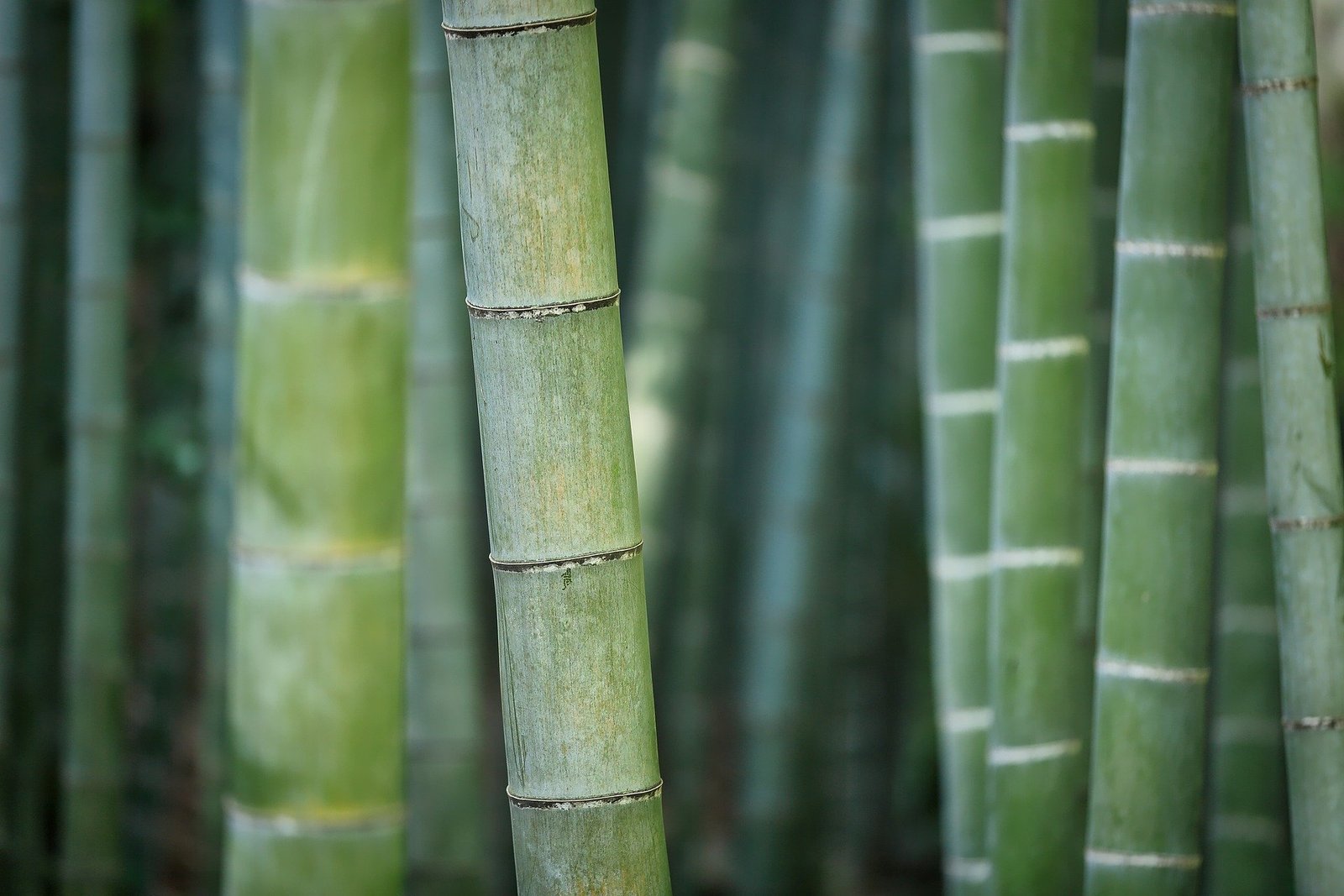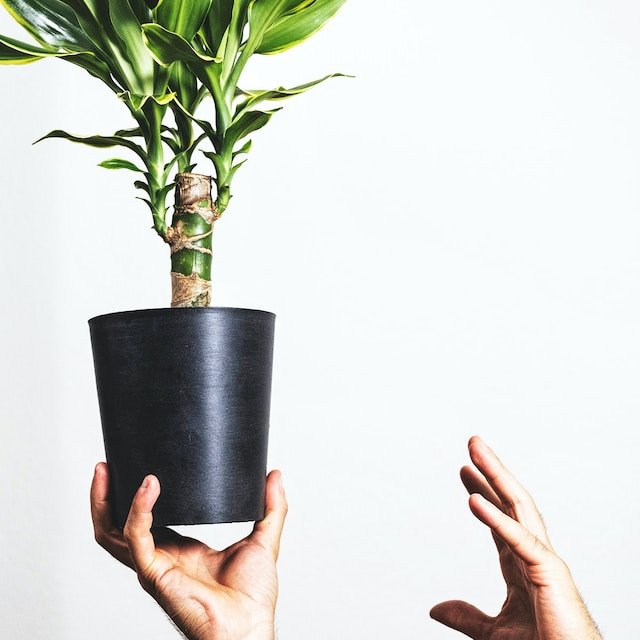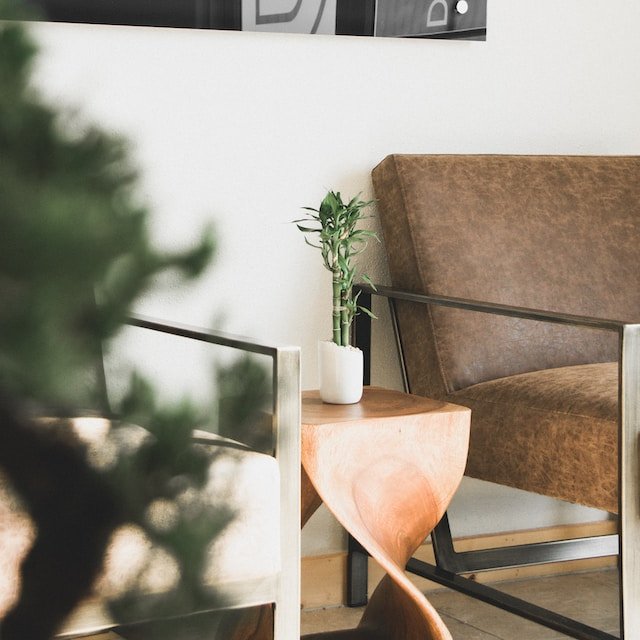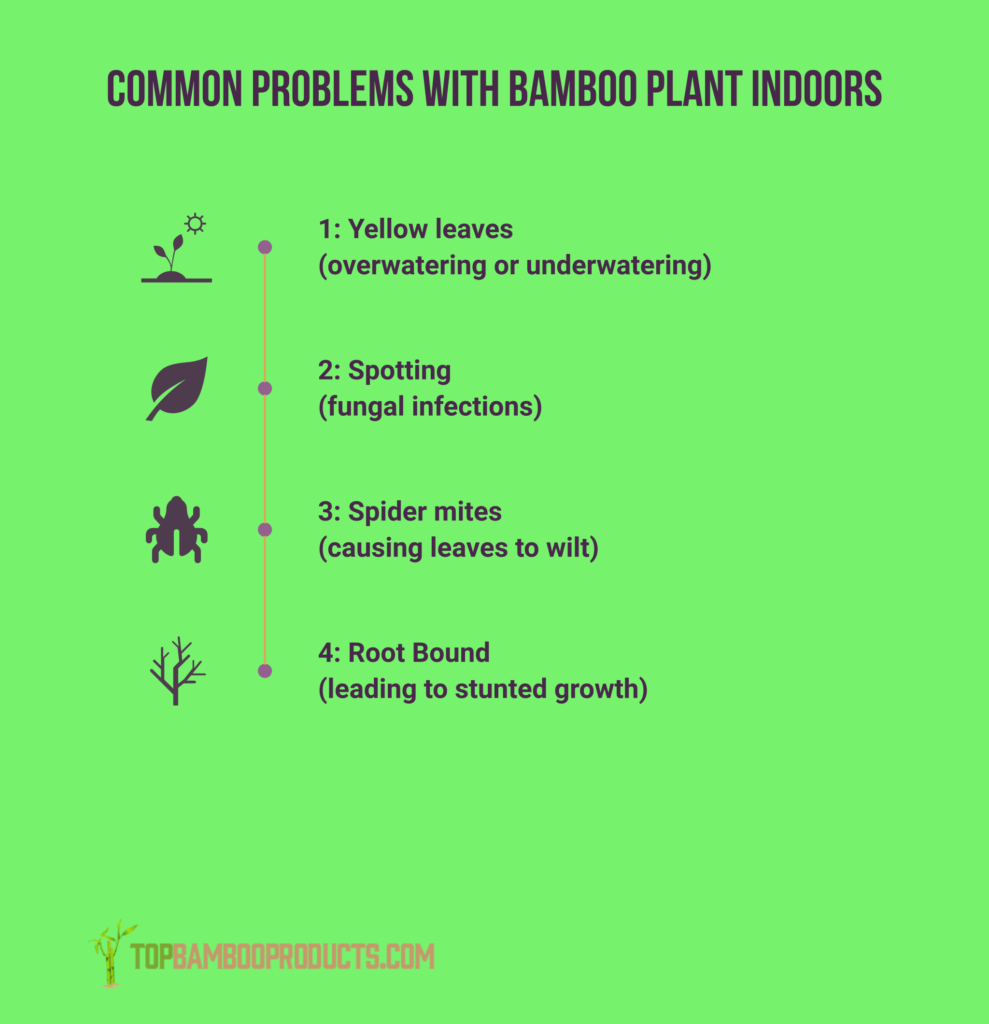How To Care For A Bamboo Plant Indoors

0Shares
Are you looking for a plant that adds some greenery to your indoor space and requires minimal maintenance? Look no further than the bamboo plant! Known for its graceful appearance and low-maintenance needs, the bamboo plant is popular among plant enthusiasts. But, like any plant, caring for a bamboo plant indoors requires knowledge and attention to detail.
In this blog, we’ll guide you through everything you need to know to keep your bamboo plant thriving inside your home. From proper watering techniques to the best potting soil, we’ll cover all the essential aspects of bamboo plant care to help you create a healthy and vibrant indoor garden.
Benefits Of Growing Bamboo Plants Indoors
 Photo by Kara Eads on Unsplash
Photo by Kara Eads on Unsplash
Are you looking for a way to add a touch of nature to your indoor space without the hassle of high-maintenance plants? Look no further than bamboo! Bamboo plants are incredibly easy to care for and come with a host of unique benefits that can enhance your home or office.
🎋 Air Purification
One of the most significant advantages of growing a bamboo plant indoors is its ability to purify the air. These plants are excellent at removing harmful toxins and pollutants from the air, making them a great choice for people with allergies or respiratory problems. Plus, they add a natural element to your indoor space, creating a calming and soothing environment that can help reduce stress and promote relaxation.
🎋 Low Maintenance
Bamboo plants are also incredibly low maintenance, requiring minimal care and attention compared to other indoor plants. They can thrive in low-light environments and don’t require much water, making them ideal for busy or inexperienced gardeners.
🎋 Feng Shui
If you’re interested in feng shui, bamboo plants symbolize good luck and prosperity in traditional Chinese culture. Placing them in specific areas of your home or office can help attract positive energy and promote peace and harmony.
🎋 Versatility
Another benefit of bamboo plants is their versatility. They come in various sizes and shapes, perfect for everything from accent pieces to privacy screens. You can even shape and prune them to create intricate patterns and designs, adding a unique touch to your decor.
Choosing A Bamboo Plant For Indoor Use
Bamboo plants are not only aesthetically pleasing, but they also offer numerous benefits for your home. They are known for their air-purifying qualities, absorbing harmful toxins and releasing fresh oxygen into the air. They also require minimal maintenance, making them a great choice for those who want to add some greenery to their home without the hassle.
When choosing a bamboo plant for indoor use, there are a few different types to consider. Here are some of the most popular options:
🎋 Lucky Bamboo
This is perhaps the most well-known bamboo plant for indoor use. Lucky Bamboo is actually not bamboo at all, but rather a member of the lily family. It is typically sold in small, ornamental containers with water and rocks. Lucky Bamboo is believed to bring good luck and prosperity, making it a popular choice for home and office décor.
🎋 Golden Bamboo
This is a beautiful variety of bamboo with yellow-green stems that can add a touch of sunshine to any room. Golden Bamboo is easy to care for and can grow up to six feet tall indoors.
🎋 Dwarf Bamboo
As the name suggests, this is a smaller variety of bamboo that is perfect for indoor use. It typically only grows to around two feet tall and has delicate, slender leaves. Dwarf Bamboo is a great choice for those who want a low-maintenance plant that won’t take up too much space.
🎋 Black Bamboo
This is a striking variety of bamboo with dark, almost black stems. Black Bamboo can grow up to ten feet tall indoors, adding a dramatic touch to any space. However, it requires a bit more maintenance than other types of bamboo, so keep that in mind if you choose this variety.
No matter which type of bamboo plant you choose, you’re sure to enjoy the natural beauty and air-purifying benefits it brings to your home.
Factors To Consider When Choosing A Bamboo Plant For Indoors

Are you looking for a way to spruce up your indoor space? If so, consider adding a bamboo plant! They add a touch of elegance to any room and can also help purify the air and create a calming atmosphere. But with so many bamboo plants, how do you know which one to select? Let’s dive into the key factors when choosing a bamboo plant indoors.
🎋 Type of bamboo plant
Did you know there are over 1,000 species of bamboo plants? It can be overwhelming trying to decide which one to bring home. But fear not, my friend! When selecting a bamboo plant for indoors, you want to focus on two main types: running and clumping bamboo. Running bamboo is a bit of a wild child and spreads like crazy, making it unsuitable for indoor spaces. On the other hand, clumping bamboo is well-behaved and grows in clusters, making it an excellent option for indoor spaces.
🎋 Size of the plant
Size matters, especially when it comes to indoor plants. Before you rush off to the nursery, take a moment to consider the available space in your indoor area. Some bamboo plants can grow up to 50 feet tall, while others remain relatively small. Choose a bamboo plant that fits well within your indoor space and allows for adequate growth.
🎋 Lighting conditions
Like most plants, bamboo needs a significant amount of light to thrive. But don’t worry; you don’t need to install a spotlight in your living room. Consider the natural light your indoor space receives before selecting a bamboo plant. If your space is dark, choose a bamboo plant that can thrive under low light conditions.
🎋 Watering requirements
Consistent watering is essential for keeping your bamboo plant healthy. But let’s be real. Life can get busy, and we forget to water our plants occasionally. So, before selecting a bamboo plant, consider your ability to provide regular watering. If you have a busy schedule, choose a bamboo plant that can tolerate occasional periods of dryness.
🎋 Temperature and humidity
Bamboo plants love warm and humid environments like tropical vacation spots. But since most of us don’t live in the tropics, we must create a suitable environment for our bamboo plants. Consider your indoor space’s temperature and humidity levels before selecting a bamboo plant. If your indoor space is too cold or dry, consider purchasing a humidifier to create an optimal environment for your bamboo plant.
🎋 Maintenance requirements
Let’s face it, some of us have a bit of a black thumb regarding plants. Before you invest in a bamboo plant, consider the maintenance requirements. Some bamboo plants require regular pruning, while others require little maintenance. Choose a bamboo plant that fits your level of commitment to plant care.
Choosing a bamboo plant indoors can be a fun and exciting adventure! By considering the type of bamboo plant, size, lighting conditions, watering requirements, temperature and humidity, and maintenance requirements, you can select a bamboo plant that will thrive in your indoor space and bring life and tranquility to your home or office.
Indoor Environment Considerations
Congratulations on your decision to bring a bamboo plant into your indoor space! Not only do bamboo plants add a touch of natural beauty to any room, but they can also provide several health benefits, such as improving air quality and reducing stress levels. However, to ensure your bamboo plant thrives in its new home, consider the indoor environment. Let’s explore some important indoor environment considerations for bamboo plants.
🎋 Temperature
Bamboo plants are native to tropical and subtropical regions, which means they thrive in warm temperatures. Ideally, the temperature in your indoor space should be between 60 and 85 degrees Fahrenheit. Remember that bamboo plants can be sensitive to sudden temperature changes, so avoid placing them near drafts or air conditioning vents.
🎋 Humidity
Humidity is another critical factor to consider when creating an optimal environment for your bamboo plant. Since bamboo plants are native to humid climates, they prefer environments with moderate to high humidity levels. If the air in your indoor space is too dry, you may need a humidifier to maintain a consistent humidity level. Alternatively, you can place a water tray near the plant to increase the humidity.
🎋 Lighting
Bamboo plants require a significant amount of light to thrive, but they can also be sensitive to direct sunlight. If your indoor space receives a lot of direct sunlight, you may need to filter the light using curtains or blinds. On the other hand, if your indoor space is dark, you may need to supplement the light using a grow light.
🎋 Watering
Consistent watering is crucial for maintaining a healthy bamboo plant. However, overwatering can be just as detrimental as underwatering. Be sure to check the soil regularly and water your bamboo plant when the top inch of the soil feels dry. You may also need to adjust your watering schedule depending on your indoor space’s temperature and humidity levels.
🎋 Air circulation
Good air circulation is essential for maintaining a healthy bamboo plant. Stagnant air can lead to the growth of mold and other harmful organisms, which can damage the plant. You can improve air circulation by placing the plant near an open window or using a fan to circulate the air.
Creating an optimal indoor environment for your bamboo plant requires careful consideration of several factors. By considering these factors and making any necessary adjustments, you can ensure that your bamboo plant thrives in its new home and brings beauty and tranquility to your indoor space.
Watering And Fertilizing Bamboo Plants Indoors

Bamboo plants are known for their exotic beauty and versatility, making them a popular choice for indoor decor. However, caring for bamboo plants indoors can be challenging, especially when watering and fertilizing them. This section will explore tips and tricks to help you keep your bamboo plants healthy and thriving.
🎋 Watering Bamboo Plants Indoors
Bamboo plants are relatively easy to care for, but they do have specific requirements when it comes to watering. It’s essential to keep the soil moist but not waterlogged, as bamboo plants are sensitive to overwatering. Here are some guidelines to follow when watering your bamboo plants:
- Frequency: Bamboo plants must be watered regularly, ideally once a week. However, the frequency may vary depending on the season, humidity, and plant size. In the summertime, when temperatures are high, you may need to water your bamboo plant twice a week. In contrast, during the winter months, when the air is drier, you can reduce the frequency to once every ten days.
- Amount: The amount of water your bamboo plant needs depends on the size of the pot and the plant itself. Generally, you should water the plant until the soil is evenly moist but not soaking wet. Avoid leaving standing water in the saucer, leading to root rot.
🎋 Fertilizing Bamboo Plants Indoors
Bamboo plants are heavy feeders, meaning they need many nutrients to grow and thrive. Regularly fertilizing your bamboo plant can help ensure it gets the nutrients it needs. Here are some tips for fertilizing your bamboo plants:
- Frequency: Bamboo plants should be fertilized every two to three months during the growing season (spring and summer). During the winter months, you can reduce the frequency to once every four to six months.
- Type of fertilizer: Bamboo plants require a balanced fertilizer with equal parts nitrogen, phosphorus, and potassium (NPK). Look for a slow-release fertilizer that will provide nutrients to the plant over time. Avoid using fertilizers with high nitrogen levels, which can lead to leaf burn.
- Amount: The amount of fertilizer your bamboo plant needs depends on its size and the fertilizer you use. Generally, use one teaspoon of fertilizer for every gallon of soil. However, always follow the instructions on the fertilizer label for the best results.
Caring for bamboo plants indoors requires a little attention and effort, but the rewards are well worth it.
Pruning And Maintenance
Bamboo plants are known for their beautiful and unique appearance, making them a popular choice for both indoor and outdoor decoration. However, if left unattended, bamboo plants can quickly become unruly and overgrown, hindering their growth and aesthetic appeal. This is where pruning and maintenance come in – essential practices that promote healthy growth and keep your bamboo plants looking their best.
🎋 Pruning
Pruning is the process of cutting back the unwanted or dead parts of the plant, encouraging new growth, and maintaining the plant’s shape and size. Regarding bamboo plants, pruning should be done during the active growing season, typically spring or summer. Here are some tips to keep in mind when pruning your bamboo:
- Identify the culms: Culms are the individual stems of the bamboo plant. Before pruning, identify the culms that need to be removed. Look for culms that are yellowing, damaged, or diseased, as well as any that grow too close together.
- Cut at an angle: When cutting the culms, be sure to do so at an angle to prevent water from pooling on the cut surface. This can lead to rot and disease, harming the plant’s health.
- Leave some culms untouched: When pruning, be sure to leave some healthy culms untouched. This will allow the plant to photosynthesize and produce food, ensuring healthy growth.
🎋 Regular maintenance
In addition to pruning, regular maintenance is essential for keeping bamboo plants looking healthy and attractive. Here are some tips for maintaining your bamboo:
- Water regularly: Bamboo plants need regular watering to thrive. Be sure to water the plant deeply, providing enough water to saturate the soil. However, be careful not to overwater, as this can lead to root rot.
- Fertilize: Bamboo plants benefit from regular fertilization, as it provides them with the nutrients they need to grow. Use a balanced fertilizer that contains nitrogen, phosphorus, and potassium.
- Control pests: Bamboo plants are susceptible to pests, including mites, scale insects, and mealybugs. Regularly inspect the plant for signs of infestation and treat it with insecticidal soap if necessary.
Pruning and maintenance are essential for keeping your bamboo plants healthy and attractive. Following these tips ensures that your bamboo plant thrives and adds beauty to your indoor or outdoor space.
Common Problems And Solutions When Taking Care Of Bamboo Plants Indoors

Like any plant, bamboo can face several challenges while being grown indoors. This section will explore some common problems bamboo plant owners face and provide practical solutions to help you keep your bamboo plant healthy and thriving.
Problem 1: Yellowing Leaves
One of the most common issues with bamboo plants is yellowing leaves. This could be due to overwatering or underwatering. Another possible reason could be too much sunlight or not enough sunlight.
Firstly, check the soil to determine if it’s moist enough. If it’s too dry, water the plant thoroughly, and allow the excess water to drain away. However, if the soil is too wet, reduce watering and allow the soil to dry out a little before watering again. Secondly, ensure that the plant receives the right amount of sunlight. Bamboo plants prefer bright, indirect sunlight. If your plant is not getting enough light, try moving it to a brighter location. Move it to a shadier spot if it’s getting too much light.
Problem 2: Leaf Spotting
If you notice black or brown spots on your bamboo plant’s leaves, it could be a sign of leaf spot. This is usually caused by fungal infections, which can spread quickly if left untreated.
To treat leaf spotting, you can use a fungicide. You can also remove the affected leaves and discard them. Additionally, avoid watering the plant from above and ensure that the plant has good ventilation to prevent moisture buildup.
Problem 3: Spider Mites
Spider mites are tiny pests that can cause significant damage to your bamboo plant. They feed on the plant’s sap, causing leaves to wilt and eventually die.
To control spider mites, wipe the leaves with a damp cloth regularly. You can also use insecticidal soap or neem oil to keep the pests at bay. Additionally, ensure that the plant is kept in a well-ventilated area to discourage the buildup of spider mites.
Problem 4: Root Bound
Bamboo plants can quickly become root-bound, leading to stunted growth and poor health.
If you notice that your bamboo plant has outgrown its container, it’s time to repot it into a larger pot. When repotting, ensure that you use fresh soil and provide adequate drainage.
Caring for bamboo plants indoors can be a fulfilling experience if done correctly. By understanding the common problems that can arise and their solutions, you can ensure that your bamboo plant remains healthy and beautiful for years to come.
Conclusion
In conclusion, caring for a bamboo plant indoors is a rewarding and fulfilling experience that requires minimal effort. With just a little bit of attention and some basic knowledge, you can enjoy the beauty and benefits of these lovely plants for years to come. Remember to keep your bamboo plant in a well-lit area, use the right soil type, and water it regularly. And don’t forget to show your plant some love by dusting its leaves and keeping it tidy.
We hope this blog has provided valuable insights and tips on caring for your bamboo plant indoors. Whether you’re a seasoned plant parent or just starting out, we encourage you to keep exploring the wonderful world of indoor gardening. There are many different plants and techniques to discover, and we’re sure you’ll find your own unique way to create a beautiful and thriving indoor garden. Thanks for reading, and happy gardening!
0Shares
